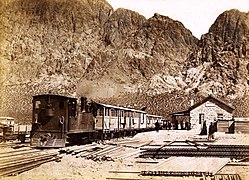Transandine Railway
| Transandine Railway | |||
|---|---|---|---|

Uspallata station, c. 1900.
|
|||
| Overview | |||
| Other name(s) | A16 Branch | ||
| Native name | Ferrocarril Trasandino | ||
| Type | Inter-city | ||
| Status | Inactive | ||
| Termini |
Mendoza, Argentina Los Andes, Chile |
||
| Stations | 17 | ||
| Operation | |||
| Opened | 1910 | ||
| Closed | 1984 | ||
| Owner |
Government of Argentina Government of Chile |
||
| Technical | |||
| Line length | 248 km (154 mi) | ||
| Number of tracks | Single track with passing loops | ||
| Track gauge | 1,000 mm (3 ft 3 3⁄8 in) metre gauge | ||
| Old gauge | ` | ||
| Minimum radius | 100 m (328.1 ft) | ||
| Electrification | 3000 V DC Overhead line | ||
| Highest elevation | 3,176 m (10,420 ft) | ||
| Maximum incline | 8% | ||
| Rack system | Abt | ||
|
|||
The Transandine Railway (Spanish: Ferrocarril Trasandino) was a 1,000 mm (3 ft 3 3⁄8 in) metre gauge combined rack (Abt system) and adhesion railway which operated from Mendoza in Argentina, across the Andes mountain range via the Uspallata Pass, to Santa Rosa de Los Andes in Chile, a distance of 248 km. The railway has been out of service since 1984, and has been partly dismantled. There has been talk about restoring the railway, but there is currently no indication of any restorative work underway.
The Transandine Railway was first projected in 1854, but the construction of the line came many years later. It was initiated by Juan and Mateo Clark, Chilean brothers of British descent, successful entrepreneurs in Valparaiso who in 1871 built the first telegraph service across the Andes, between Mendoza in Argentina and Santiago in Chile.
In 1874 the Chilean government granted them the concession for the construction of the rail link. Because of financial problems, their company, Ferrocarril Trasandino Clark, did not begin work on the construction in Los Andes until 1887. The section between Mendoza and Uspallata was opened on 22 February 1891 and extended to Rio Blanco on 1 May 1892, to Punta de Vacas on 17 November 1893, to Las Cuevas on 22 April 1903. On the Chilean side the section from Santa Rosa de Los Andes to Hermanos Clark was opened in 1906, and extended to Portillo in February 1908. The entire line was first opened to traffic in 1910. By then the company had been taken over by the British-owned Argentine Transandine Railway Company.
The line followed roughly the ancient route taken by travellers and mule-trains crossing the Andes between Chile and Argentina and connected the broad gauge, 5 ft 6 in (1,676 mm), railway networks of the two countries, rising to a height of almost 3,200 metres at Las Cuevas where the track entered the Cumbre tunnel, about 3.2 km long, on the international border. Nine sections of rack were laid in the last 40 km of track on the Argentine approach to the tunnel, ranging from 1.2 km to 4.8 km in length, with a maximum gradient of 1 in 17 (5.88%). On the Chilean side there were seven sections of rack in just 24 km, of which one section was 16 km long with an average gradient of 1 in 13 (7.69%). Sections of the line were protected by snowsheds and tunnels.
...
Wikipedia

